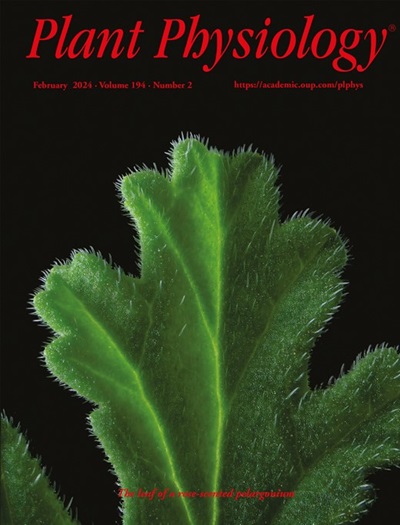VULGARE row - 65与分蘖启动子和花同源基因结合,调控其表达。
IF 6.9
1区 生物学
Q1 PLANT SCIENCES
引用次数: 0
摘要
茎部结构或分蘖的变异是作物驯化过程中一个重要的适应性状。一个众所周知的调控因子是TEOSINTE BRANCHED 1 (TB1)。TB1及其同源基因在整合环境信号调控谷物腋生分枝或分蘖方面具有保守功能。大麦(Hordeum vulgare) TB1同源基因vulgare row- type6 - 5 (VRS5)调节分蘖,并通过抑制侧小穗发育参与调节行型。这些发现主要来自基因研究;然而,VRS5如何在分子水平上调控这些过程仍是未知的。通过结合vrs5突变体与野生型在不同发育阶段的转录组分析和dap测序定位vrs5的全基因组DNA结合位点,我们确定了vrs5的真正靶点。我们发现VRS5靶向脱落酸相关基因,可能以保守的方式抑制分蘖。在花序发育后期,VRS5还会靶向行型基因VRS1和一些已知的花发育基因,如mikcc型MADS-box基因。这项研究确定了几个基因进行突变分析,代表了对真正目标的选择,这将有助于更深入地了解VRS5网络及其在塑造大麦发育中的作用。本文章由计算机程序翻译,如有差异,请以英文原文为准。
VULGARE ROW-TYPE SIX 5 binds to the promoter of tillering and floral homeotic genes to regulate their expression.
Variation in shoot architecture, or tillering, is an important adaptive trait targeted during the domestication of crops. A well-known regulatory factor in shoot architecture is TEOSINTE BRANCHED 1 (TB1). TB1 and its orthologs have a conserved function in integrating environmental signals to regulate axillary branching or tillering in cereals. The barley (Hordeum vulgare) ortholog of TB1, VULGARE ROW-TYPE SIX 5 (VRS5), regulates tillering and is involved in regulating row-type by inhibiting lateral spikelet development. These discoveries predominantly come from genetic studies; however, how VRS5 regulates these processes on a molecular level remains largely unknown. By combining transcriptome analysis between the vrs5 mutant and the wild type at different developmental stages and DAP-sequencing to locate the genome-wide DNA binding sites of VRS5, we identified bona fide targets of VRS5. We found that VRS5 targets abscisic acid-related genes, potentially to inhibit tillering in a conserved way. Later in inflorescence development, VRS5 also targets row-type gene VRS1 and several known floral development genes, such as MIKCc-type MADS-box genes. This study identifies several genes for mutational analysis, representing a selection of bona fide targets that will contribute to a deeper understanding of the VRS5 network and its role in shaping barley development.
求助全文
通过发布文献求助,成功后即可免费获取论文全文。
去求助
来源期刊

Plant Physiology
生物-植物科学
CiteScore
12.20
自引率
5.40%
发文量
535
审稿时长
2.3 months
期刊介绍:
Plant Physiology® is a distinguished and highly respected journal with a rich history dating back to its establishment in 1926. It stands as a leading international publication in the field of plant biology, covering a comprehensive range of topics from the molecular and structural aspects of plant life to systems biology and ecophysiology. Recognized as the most highly cited journal in plant sciences, Plant Physiology® is a testament to its commitment to excellence and the dissemination of groundbreaking research.
As the official publication of the American Society of Plant Biologists, Plant Physiology® upholds rigorous peer-review standards, ensuring that the scientific community receives the highest quality research. The journal releases 12 issues annually, providing a steady stream of new findings and insights to its readership.
 求助内容:
求助内容: 应助结果提醒方式:
应助结果提醒方式:


